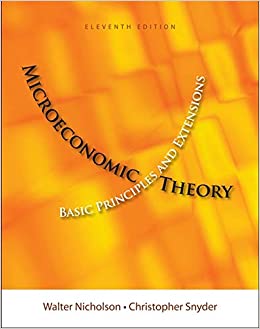
Microeconomic Theory 11th Edition by Walter Nicholson,Christopher Snyder
Edition 11ISBN: 978-1111525538
Microeconomic Theory 11th Edition by Walter Nicholson,Christopher Snyder
Edition 11ISBN: 978-1111525538 Exercise 1
A monopolist faces a market demand curve given by
Q = 70- p:
a. If the monopolist can produce at constant average and marginal costs of AC = MC = 6, what output level will the monopolist choose to maximize profits? What is the price at this output level? What are the monopolist's profits?
b. Assume instead that the monopolist has a cost structure where total costs are described by

With the monopolist facing the same market demand and marginal revenue, what price-quantity combination will be chosen now to maximize profits? What will profits be?
c. Assume now that a third cost structure explains the monopolist's position, with total costs given by

Again, calculate the monopolist's price-quantity combination that maximizes profits. What will profit be? Hint: Set MC = MR as usual and use the quadratic formula to solve the second-order equation for Q.
d. Graph the market demand curve, the MR curve, and the three marginal cost curves from parts (a), (b), and (c). Notice that the monopolist's profit-making ability is constrained by (1) the market demand curve (along with its associated MR curve) and (2) the cost structure underlying production.
Q = 70- p:
a. If the monopolist can produce at constant average and marginal costs of AC = MC = 6, what output level will the monopolist choose to maximize profits? What is the price at this output level? What are the monopolist's profits?
b. Assume instead that the monopolist has a cost structure where total costs are described by

With the monopolist facing the same market demand and marginal revenue, what price-quantity combination will be chosen now to maximize profits? What will profits be?
c. Assume now that a third cost structure explains the monopolist's position, with total costs given by

Again, calculate the monopolist's price-quantity combination that maximizes profits. What will profit be? Hint: Set MC = MR as usual and use the quadratic formula to solve the second-order equation for Q.
d. Graph the market demand curve, the MR curve, and the three marginal cost curves from parts (a), (b), and (c). Notice that the monopolist's profit-making ability is constrained by (1) the market demand curve (along with its associated MR curve) and (2) the cost structure underlying production.
Explanation
The consumer surplus is the difference b...
Microeconomic Theory 11th Edition by Walter Nicholson,Christopher Snyder
Why don’t you like this exercise?
Other Minimum 8 character and maximum 255 character
Character 255


